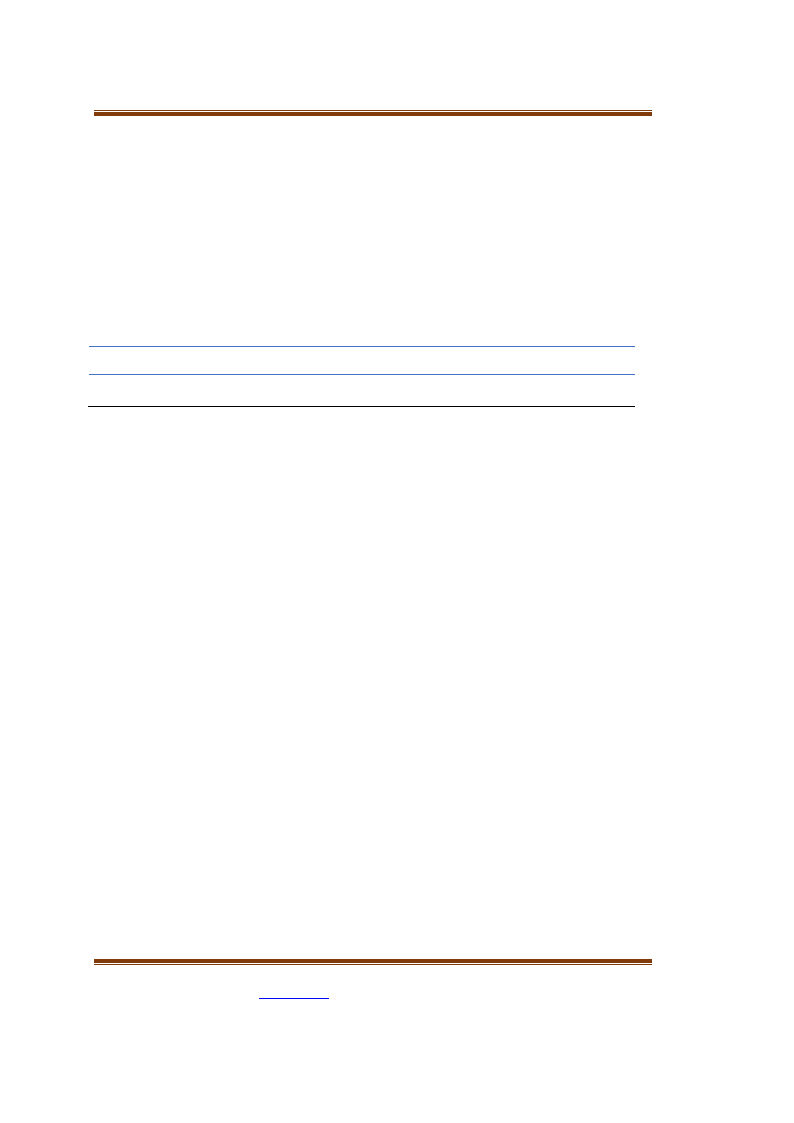
AFRREV VOL 14 (1), S/NO 57, JANUARY, 2020
African Research Review: An International
Multidisciplinary Journal, Ethiopia
AFRREV Vol. 14 (1), Serial No 57, January, 2020: 61-71
ISSN 1994-9057 (Print) ISSN 2070-0083 (Online)
DOI: http://dx.doi.org/10.4314/afrrev.v14i1.6
Status of Principals’ ICT Usage in Secondary School Administration
in Rivers State
Abraham, Lois Nkechi
Department of Curriculum Studies and Educational Technology
Faculty of Education
University of Port Harcourt, Port Harcourt
Rivers State, Nigeria
E-mail: lois.abraham@uniport.edu.ng
Bariyaa, John
Department of Educational Management
Faculty of Education
Ignatius Ajuru University of Education, Rumuolumeni
Port Harcourt, Nigeria
Abstract
This study examined the status of principals’ ICT usage in secondary school administration in
Rivers State. The study adopted a descriptive research design. The population of the study
was 276 Principals from the 276 Senior Secondary Schools in Rivers State. A sample size of
138 was drawn using simple random sampling techniques. This represented 50% of the total
population. Five research questions and five hypotheses guided the study. A self-designed
questionnaire tagged “Principals’ Information and Communication Technology Usage
Questionnaire (PICTUQ)”, which was a modified 2 points rating scale of YES =2 points and
NO= 1 point. The data were analyzed using Mean and Standard Deviation. The criterion
mean of 1.50 was used as benchmark for taking decision of each of the items of the research
questions. Any score up to 1.50 and above was accepted; while score below 1.50 was rejected
as not having desired impact. The z-test was used to test the hypotheses. The findings of the
study revealed that both the rural and urban principals upheld the fact that there is no
computer laboratory, computers, scanners, projector and power generating plants in public
secondary schools in Rivers State. The study recommended that: ICT facilities should be
COPYRIGHT © IAARR: https://www.afrrevjo.net
61
Indexed African Journals Online: www.ajol.info
Indexed Society of African Journals Editors (SAJE); https://africaneditors.org/

AFRREV VOL 14 (1), S/NO 57, JANUARY, 2020
installed in all secondary schools in Rivers State; adequate number of experts should be
employed to train principals and students in ICT; adequate funds should be provided to
manage the process for adequate educational quality service delivery in schools; government
should set committee to install and monitor ICT facilities and its usage in public schools in
Rivers State.
Key Words: ICT, Administration, ICT access, ICT application, ICT literacy, Principals’
performance.
Introduction
The need to become visible, accessible and relevant to the world has made educational
managers to embrace and incorporate Information and Communication Technology (ICT) in
secondary school administration. This is with the aim of improving principals’ administrative
performance with its attendant productivity. Abraham and Chuku (2018) averred that ICT is a
system derived from the intermingling of Information Technology (IT) and Communication
Technology (CT). It could also be defined as the application of electronic media (Computers,
telecommunication gadgets, digital media, mobile devices, Personal Digital Assistants
(PDAs) etc. in the acquisition, processing, storage, retrieving, and dissemination of
Information. Nwaoma in Kalu, Mmereole and Osuocha (2017) opined that ICT, a terminology
for information and communication system is a generic term referring to technology which is
used for collecting, storing, editing and passing on of information in various forms.
Information and Communication Technology in the educational parlance refers to the
technology that is manipulated using electronic devices to transmit data, graphics, symbols,
sounds, videos, messages and pictures to achieve specific and broad educational goals.
Educational stakeholders – society, government, organizations and parents are interested in
getting viable information about pupils’ performance. This expectation informed the need for
appropriate technological platform to adequately communicate, interact or interface with the
students and transmit their progress or challenges to the stakeholders even at the comfort of
homes and offices. This problem is not peculiar to Rivers state alone. In the same vein,
Eguwunyenga in Kalu, Mmereole and Osuocha (2017) further observed that in most public
senior secondary schools in the North-Central of Nigeria, officials still go through the
laborious exercise of manually registering students, maintaining records of pupils’
performance, keeping inventory list of supplies, etc.
One of the common features of the 21st century teaching is that there is a shift from analogue
(usual manual) teaching to a digitally based (technological) teaching. This idea is in
agreement with the proposition of Abraham and Chuku (2018) that the 21st century education
emphasizes a technological-based education that is problem-solving. Modern day teachers
need ICT (information and skills) to professionally balance in the global knowledge wave.
Barawi (2017) propose that information referred to the knowledge obtained from the
processing, manipulation, and transmission of raw data into a meaningful form for decision-
making. Information is paramount in administration processes and therefore, needs to be
communicated.
Communication according to Inegbu (2018) is the passage or transmission of information
from a source to a receiver through a channel. The source of information to students are the
teachers, hence the necessity of being equipped for their task.
Administrators and teachers need to be acquainted with the scientific methods of managing
information due to the multiplicity of educational interest groups and their geographical
COPYRIGHT © IAARR: https://www.afrrevjo.net
62
Indexed African Journals Online: www.ajol.info
Indexed Society of African Journals Editors (SAJE); https://africaneditors.org/

AFRREV VOL 14 (1), S/NO 57, JANUARY, 2020
distance. Barawi (2017) viewed technology as the use of scientific knowledge, experiences
and resources to create and process products that serve human needs. ICT usage of principals
centres on their ability to manage secondary schools information through appropriate
communication media that are technologically based.
Therefore, the acquisition and usage of ICT knowledge by principals (administrators) is
necessary for the fulfilment of their societal educational duties and at the same time satisfy
their statutory educational obligations. To this end, Ojo (2012) submitted that the
management of students’ record with ICT in secondary school effectively lies in the hands of
staff that are computer literate.
Statement of the Problem
A visit to some public secondary schools in Rivers State revealed that some principals do not
have ICT facilities. This does not only constitute a problem but causes a gap in the global
trend. More than ever before, education is becoming more digital. As a result, Webber in
Solomon (2013) pointed out that despite the success registered in the use of information
technology in other sectors of the economy, educational institutions have lagged in the
integration of computers for schools management purposes.
Not minding the sensitization programmes and availability of computers in few schools in
Rivers State, there is minimal usage of ICT by principals in secondary schools management.
This is occasioned by the fact that they lack the skills and dexterity to manipulate these
gadgets.
It is disgusting and obsolete to observe that schools still provide regular statistical returns to
Schools’ Board and Ministry of Education through manual letters, letter by posts, couriers or
by telephone conversation. The researchers argue that these methods are not only archaic but
practically slow, time consuming, expensive and prone to unnecessary errors.
Apart from the fact that government has failed to give necessary attention to staff training and
development in this area, Wilding and Blackford in Everlyne (2010) in their research report
argued that educators need to experience a major technological change management
programme in order to start addressing the new situation. Up till now, some principals are yet
to avail themselves the opportunity of acquiring computer knowledge that will enable them
manage the technological challenges resulting from ICT in school administration.
Aim and Objectives
This study aimed at investigating the status of principals’ ICT usage in secondary schools
administration in Rivers State.
The objectives therefore include to:
1. investigate the availability of ICT facilities in secondary school administration in
Rivers State.
2. identify the skills possessed by the principals in utilizing ICT facilities in secondary
school administration in Rivers State.
3. investigate the status of principals’ ICT application in secondary school
administration in Rivers State.
4. investigate the socio-demographic factors that influence principals’ ICT usage in
secondary school in Rivers State.
COPYRIGHT © IAARR: https://www.afrrevjo.net
63
Indexed African Journals Online: www.ajol.info
Indexed Society of African Journals Editors (SAJE); https://africaneditors.org/

AFRREV VOL 14 (1), S/NO 57, JANUARY, 2020
5. investigate the roles of principals’ ICT usage in improving secondary school
administration in Rivers State.
Research Questions
1. What are the ICT facilities available in secondary school administration in Rivers
State?
2. What are the skills possessed by principals in utilizing ICT facilities in secondary
school administration in Rivers State?
3. What is the status of principals’ ICT application in secondary school administration in
Rivers State?
4. What are the socio-demographic factors that influence principals’ ICT usage in
secondary school administration in Rivers State?
5. What are the roles of principals’ ICT usage in improving secondary school
administration in Rivers State?
Hypotheses
1. There is no significant difference between the mean ratings of urban and rural
principals on the availability of ICT facilities in secondary school administration in
Rivers State.
2. There is no significant difference between the mean ratings of urban and rural
principals on the skills possessed by the principals in utilizing ICT facilities in
secondary school administration in Rivers State.
3. There is no significant difference between the mean ratings of urban and rural
principals on the status of principals’ ICT application in secondary school
administration in Rivers State.
4. There is no significant difference between the mean ratings of urban and rural
principals on the socio-demographic factors that influence principals’ ICT usage in
secondary school administration in Rivers State.
5. There is no significant difference between the mean ratings of urban and rural
principals on the roles of principal’s ICT usage in improving secondary school
administration in Rivers State.
Methodology
The descriptive research design was adopted. The population consisted of 276 principals in
the 276 public secondary schools in Rivers State. The sample size was 138 which represent
50% of the total population. This was achieved through simple random sampling technique.
The instrument for data collection was a questionnaire titled “Principals’ Information and
Communication Technology Usage Questionnaire (PICTUQ)”, which was a 2 points rating
scale of YES =2 points and NO= 1 point. The data were analyzed using mean and standard
deviation. The criterion mean of 1.50 was used as benchmark for taking decision on each of
the items. Any score up to 1.50 and above was accepted; while score below 1.50 was rejected
as not having desired impact. Z-test was used to test the hypotheses at 0.05 level of
significance.
COPYRIGHT © IAARR: https://www.afrrevjo.net
64
Indexed African Journals Online: www.ajol.info
Indexed Society of African Journals Editors (SAJE); https://africaneditors.org/

AFRREV VOL 14 (1), S/NO 57, JANUARY, 2020
Results
Research Question One: What are the ICT facilities available in secondary school
administration in Rivers State?
Table 1: Mean ratings and standard deviation of urban and rural teachers in public secondary
school on the ICT facilities available in secondary school administration in Rivers State.
S/no Availability of computer Rural= 70 Urban= 68
Mean set Decision
facilities in secondary schools
administration in Rivers
State?
−
SD1 −
SD2
X1
X2
1
Computer lab.
1.4 1.2 1.4 1.2 1.4
Rejected
2
Computer(s)
1.4 1.2 1.3 1.1 1.4
Rejected
3
Scanner, photocopier, printer 1.3 1.1 1.2 1.1 1.3
Rejected
4
Projector
1.4 1.2 1.2 1.1 1.3
Rejected
5
Plant
1.4 1.2 1.3 1.1 1.4
Rejected
Aggregate
1.4 1.2 1.3 1.1 1.4
Rejected
Table one showed that all the items 1, 2, 3, 4and 5, and their aggregate mean sets of 1.4, 1.4,
1.3, 1.3, and 1.4 were rejected. The aggregate response of both rural and urban principals
(1.4) was below the criterion mean of 1.50.
Research Question Two: What are the skills possessed by the principals in utilizing ICT
facilities in secondary schools administration in Rivers State?
Table 2: Mean ratings and standard deviation of urban and rural teachers in public secondary
school on the skills possessed by the principals in
utilizing ICT facilities in secondary schools’ administration in Rivers State.
S/no Skills possess by the principals Rural=70
Urban=68 Mean set Decision
in utilizing ICT facilities in
secondary
schools
−
administration in Rivers State. X 1
SD1
−
SD2
X2
1
Microsoft word
1.4 1.2 1.3 1.1 1.4
2
Microsoft excel
1.3 1.1 1.4 1.2 1.4
3
Microsoft PowerPoint
1.4 1.2 1.4 1.2 1.4
4
Sending and receiving mails
1.5 1.2 1.5 1.2 1.5
5
Whatsapp /Facebook
1.5 1.2 1.5 1.2 1.5
Aggregate
1.4 1.2 1.4 1.2 1.4
Rejected
Rejected
Rejected
Accepted
Accepted
Rejected
Table 2 showed that the aggregate mean of the respondents’ responses of 1.4 was below the
criterion mean of 1.50. However, only items 4 and 5 which were ‘sending and receiving
mails’, and ‘whatsapp/Facebook’ respectively met the criterion mean of 1.5. Both rural and
urban school principals possess those ICT skills.
COPYRIGHT © IAARR: https://www.afrrevjo.net
65
Indexed African Journals Online: www.ajol.info
Indexed Society of African Journals Editors (SAJE); https://africaneditors.org/

AFRREV VOL 14 (1), S/NO 57, JANUARY, 2020
Research Question Three: What are the statuses of principals’ ICT application in secondary
schools administration in Rivers State?
Table 3: Mean ratings and standard deviation of urban and rural teachers in public secondary
school on the status of principals’ ICT application in secondary schools administration in
Rivers State.
S/no Principals’ ICT application in Rural=70
Rural=68
Mean set Decision
secondary schools administration
in Rivers State
−
SD1
X1
−
SD2
X2
1
Taking inventory of school assets 1.4 1.2 1.3 1.1 1.4
Rejected
2
Management of human resources 1
1
1.5 1.2 1.3
3
Monitoring of learning process 1.3 1.1 1.3 1.1 1.3
4
Monitoring of admission
1.4 1.2 1.1 1.3 1.3
5
Monitoring of students result
1.4 1.2 1.3 1.1 1.4
Aggregate
1.3 1.1 1.
1.1 1.4
Rejected
Rejected
Rejected
Rejected
Rejected
Table 3 showed that all the items, 1,2,3,4 and 5, and their mean sets of 1.4, 1.3, 1.3, 1.3, and
1.4 were rejected. This was because their aggregate mean set of 1.4 was below the criterion
mean of 1.50.
Research Question Four: What are the socio-demographic factors that influence principals’
ICT usage in public secondary school in Rivers State?
Table 4: Mean ratings and standard deviation of urban and rural teachers in public secondary
school on the socio-demographic factors that influence principals’ ICT usage in secondary
schools in Rivers State
S/no Socio-demographic
factors Rural=70 Urban=68 Mean set Decision
influencing principals’ ICT usage
in
secondary
schools
administration in Rivers State
−
X1
SD1
−
SD2
X2
1
Security
1.5 1.2 1.6 1.3 1.6
Accepted
2
Skilled personnel
1.5 1.3 1.5 1.2 1.6
Accepted
3
Resistance to change
1.5 1.2 1.6 1.3 1.6
Accepted
4
Electricity supply
1.5 1.2 1.5 1.2 1.5
Accepted
5
inadequate or no supply of 1.6 1.3 1.5 1.2 1.6
Accepted
computer
Aggregate
1.5 1.2 1.5 1.3 1.5
Accepted
Table 4 showed that all the items 1,2,3,4 and 5 and their aggregate means of 1.6, 1.6, 1.6, 1.5,
and 1.6 were accepted. The table also indicated that the respondents’ responses of 1.5 met the
criterion mean which was the benchmark for accepting the research question.
COPYRIGHT © IAARR: https://www.afrrevjo.net
66
Indexed African Journals Online: www.ajol.info
Indexed Society of African Journals Editors (SAJE); https://africaneditors.org/

AFRREV VOL 14 (1), S/NO 57, JANUARY, 2020
Research Question Five: What are the roles of principals’ ICT usage in improving secondary
school administration in Rivers State?
Table 5: Mean ratings and standard deviation of urban and rural teachers in public secondary
school on the roles of principals’ ICT usage in improving secondary school administration in
Rivers State
S/no Roles of principals’ ICT usage Rural=70
Urban=68 Mean Decision
in improving secondary
set
schools administration in
−
Rivers State
X1
SD1
−
SD2
X2
1
Expand access and learning 1.6 1.3 1.5 1.2 1.6
Accepted
opportunities
2
It improves education quality 1.7 1.3 1.5 1.2 1.6
Accepted
3
Fast and easy management of 1.6 1.3 1.6 1.3 1.6
Accepted
information
4
Helps to share educational 1.6 1.3 1.6 1.3 1.6
Accepted
resources
5
Improves
system 1.5 1.2 1.6 1.3 1.6
Accepted
communication
Aggregate
1.6 1.3 1.6 1.3 1.6
Accepted
Table 5 showed that all the items 1,2,3,4 and 5 and their aggregate means of 1.6, 1.6, 1.6, 1.6,
1.6 were accepted. The table also indicated that the respondents’ response of 1.6 was above
the criterion mean of 1.50 that was the benchmark for accepting the research question.
Test of Hypotheses
Ho1: There is no significant difference between the mean ratings of urban and rural principals
on the availability of ICT facilities in secondary school administration in Rivers State.
Table 6: z-test of difference between the mean ratings of urban and rural principals on the
availability of ICT facilities in secondary school administration in Rivers State
Status N
−
SD
df
Z-cal Z-crit Decision
X
Urban 70
1.4
1.2
136
0.19 1.96
Rejected
Rural
68
1.3
1.1
Table 6 revealed that z-calculated (0.19) was less than the z-critical (1.96) at 0.05 level of
significance. Based on the decision rule, (z-cal≤ z-crit), the null hypothesis was accepted.
This implied that, there is no significant difference between the mean ratings of urban and
rural principals on the availability of ICT facilities in secondary schools administration in
Rivers State.
COPYRIGHT © IAARR: https://www.afrrevjo.net
67
Indexed African Journals Online: www.ajol.info
Indexed Society of African Journals Editors (SAJE); https://africaneditors.org/

AFRREV VOL 14 (1), S/NO 57, JANUARY, 2020
Ho2: There is no significant difference between the mean ratings of urban and rural principals
on the skills possess by the principals in utilizing ICT facilities in secondary school
administration in Rivers State.
Table 7: z-test of difference between the mean ratings of urban and rural principals onthe
skills possess by the principals in utilizing ICT facilities in secondary school administration in
Rivers State.
Status N
−
SD df
Z-cal
Z-crit
Decision
X
Urban
70
1.4
1.2 136
0.20
1.96
Rejected
Rural
68
1.4
1.2
Table 7 revealed that z-calculated (0.20) was less than the z-critical (1.96) at 0.05 level of
significance. Based on the decision rule (z-cal≤ z-crit), the null hypothesis was accepted. By
implication, the null hypothesis was upheld that there is no significant difference between the
mean ratings of urban and rural principals on the skills possess by the principals in utilizing
ICT facilities in secondary schools administration in Rivers State.
Ho3: There is no significant difference between the mean ratings of urban and rural principals
on the status of principals’ ICT application in secondary schools administration in Rivers
State.
Table 8: z-test difference between the mean ratings of urban and rural principals on the
status of principals’ ICT application in secondary schools administration in Rivers State
Status
N
Urban
70
Rural
68
−
SD
X
1.3
1.1
1.1
1.1
df
Z-cal
Z-crit
Decision
136
0.`8
1.96
Rejected
Table 8 showed that z-calculated (0.18) was less than the z-critical (1.96) at 0.05 level of
significance. Based on the decision rule, (z-cal≤ z-crit), the null hypothesis was maintained.
This implied that, there is no significant difference between the mean ratings of urban and
rural principals on the status of principal’s ICT application in secondary schools
administration in Rivers State.
Ho4: There is no significant difference between the mean ratings of urban and rural principals
on the socio-demographic factors that influence principal’s ICT usage in secondary schools
principals in Rivers State.
Table 9: There is no significant difference between the mean ratings of urban and rural
principals on the socio-demographic factors that influence principal’s ICT usage in secondary
schools principals in Rivers State.
Status
N
Urban
70
Rural
68
−
SD
X
1.5
1.2
1.5
1.3
df
Z-cal Z-crit Decision
136
0.21
1.96
Accepted
COPYRIGHT © IAARR: https://www.afrrevjo.net
68
Indexed African Journals Online: www.ajol.info
Indexed Society of African Journals Editors (SAJE); https://africaneditors.org/

AFRREV VOL 14 (1), S/NO 57, JANUARY, 2020
Table 9 showed that z-calculated (0.21) was less than the z-critical (1.96) at 0.05 level of
significance. Based on the decision rule (z-cal≤ z-crit), the null hypothesis was accepted. This
implied that, there is no significant difference between the mean ratings of urban and rural
principals on the socio-demographic factors that influence principals’ ICT usage in secondary
schools principals in Rivers State.
Ho5: There is no significant difference between the mean ratings of urban and rural principals
on the roles of principal’s ICT usage in improving secondary schools administration in Rivers
State.
Table 10: z-test of difference between the mean ratings of urban and rural principals on the
roles of principal’s ICT usage in improving secondary schools administration in Rivers State
Status
Urban
Rural
N
−
X
70 1.6
68 1.6
SD
df
Z-cal
Z-crit
Decision
1.3
136 0.22
1.96
Accepted
1.3
Table 10 showed that z-calculated (0.22) was less than the z-critical (1.96) at 0.05 level of
significance. Based on the decision rule (z-cal≤ z-crit), the null hypothesis was upheld that,
there is no significant difference between the mean ratings of urban and rural principals on the
roles of principals’ ICT usage in improving secondary schools administration in Rivers State.
Discussion of Findings
The study revealed that both the rural and urban principals upheld the fact that there is no
computer lab, computers, scanner, projector and plants in public secondary schools in Rivers
State. The technologies that is embedded in ICT are computers, internet, broadcasting
technologies (radio and television), and telephone (Chigozie-Okwum, 2018). Webber in
Solomon (2013) over out that despite the success registered in the use of information
technology in other sectors of economy, educational institutions have lagged in the integration
of computers for schools management purpose.
The study revealed that most public secondary school principals do not possess ICT skills
such as Microsoft word, Microsoft excel, Microsoft PowerPoint, sending and receiving mails
and Facebook or WhatsApp.
The study showed that most principals in urban and rural public schools do not know how to
use ICT for taking inventory of school assets, management of human resources, monitoring
learning process, monitoring admission, and monitoring students’ results. Eguwunyenga in
Kalu, Mmereole and Osuocha (2017) further observed that in most public senior secondary
schools in Nigeria, officials still go through the laborious exercise of manually registering
students, maintaining records of pupils’ performance, and keeping inventory list of supplies
The study revealed that urban and rural principal accepted that socio-demographic factor
influencing principals’ ICT usages are security, skilled personnel, resistance to change,
electricity and inadequate supply of computer.
The study also revealed that principals of urban and rural public schools in Rivers State
accepted that expanded access and learning opportunities, improved education quality, fast
and easy management of information, sharing of educational resources, and improvement in
communication system were roles that improve secondary school administration.
COPYRIGHT © IAARR: https://www.afrrevjo.net
69
Indexed African Journals Online: www.ajol.info
Indexed Society of African Journals Editors (SAJE); https://africaneditors.org/

AFRREV VOL 14 (1), S/NO 57, JANUARY, 2020
Conclusion
Principals’ administrative functions required ICT aids in order to remain relevant in the
education system. ICT facilities are not only needed by the principals but they can be of
immense importance to the students as well.
Recommendations
The study recommends that:
1. ICT facilities should be installed in all secondary schools in Rivers State
2. Adequate number of experts should be employed to train principals and students in
this area.
3. Appropriate security gadgets should be put in 0place to secure these facilities (when
provided and installed).
4. Adequate funds should be provided to fund the process for quality educational service
delivery in schools.
5. Government should set committee to install and monitor ICT facilities and its usage
in public schools in Rivers State.
References
Abraham, L. N., & Chuku, B. J. (2018). Application of Information and Communication
Technology (ICT) in teaching Geography in Secondary Schools in Obio/Akpor,
Rivers state, Nigeria. International Journal of Scientific Research in Education,
11(1), 28-50.
Barawi, M.N. (2017). Everyday computing: An ICT approach (3rd Ed.) Nigeria: Jomat
Services.
Chigozie-ogbum, C.C. (2018). Policies on information and communication technology
education planning. In Ololube, N.P. (Ed.) Handbook on research and educational
planning and policy analysis (256-278), Port Harcourt: Pearl publishers.
Everlyne, S. M. (2010). Principals’ literacy in information and communication technology
(ICT): towards improving secondary school performance in Kenya. A Doctor of
Education Thesis, University of South Africa.
Inegbo, S.O. (2018). Barriers to effective communication in institutions: The key to effective
management. In Ololube, N. P. (Ed.) Encyclopedia of institutional leadership, policy
and management (491-500). Port Harcourt: Pearl publishers.
Kalu, C., Mmereole, N., & Osuocha O. (2017). Influence of ICT on the management of
student records in public senior secondary schools in Nassarawa State. Nigerian
Journal of Education Administration and Planning. 17(4) 1219-1230
Maduabum, M.A. (2007). Fundamentals of educational research (3rd. Ed.) Port Harcourt:
Firstborn Printers.
Ogenme, U. (2018). Communication and management of change in institution. In Ololube, N.
P. (Ed.) Encyclopedia of institutional leadership, policy and management (534-549),
Port Harcourt: Pearl publishers.
COPYRIGHT © IAARR: https://www.afrrevjo.net
70
Indexed African Journals Online: www.ajol.info
Indexed Society of African Journals Editors (SAJE); https://africaneditors.org/

AFRREV VOL 14 (1), S/NO 57, JANUARY, 2020
Ogoche, M. D., Haruna J. E., Animoku, E.A., Usman, S. & Shuaibu, K. (2017). Utilization of
information and technology in the management of staff personnel services for value-
reorientation and sustainable national development in private colleges of education in
North-Central of Nigeria. Nigerian Journal of Educational Administration and
Planning. 17(4) 1206-1218.
Ojo, D. (2012). An exploratory study of some correlates sustainable electronic health
information management system in Nigeria teaching hospital. A Ph.D. pre-field
seminar presented to the Department of Information resources Management, Babcock
University of Postgraduate Studies. Unpublished.
Oluyemisi, A. O. (2015). ICT and effective school management: administrators’ perspective.
Proceedings of the World Congress on Engineering (1) 1 - 3, London, U.K.
Solomon, M. (2013). Effect of computers in management of secondary schools in Kenya a
case of west Pokot County, Kenya. Unpublished M.A. Thesis Department of
Extramural Studies, of the University of Nairobi, Kenya.
COPYRIGHT © IAARR: https://www.afrrevjo.net
71
Indexed African Journals Online: www.ajol.info
Indexed Society of African Journals Editors (SAJE); https://africaneditors.org/
